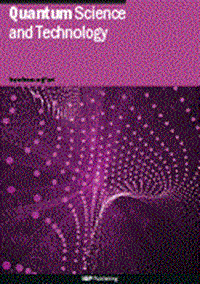利用幅度和频率约束脉冲对受退相干影响的自旋量子的最优控制
IF 5.6
2区 物理与天体物理
Q1 PHYSICS, MULTIDISCIPLINARY
引用次数: 0
摘要
量子最优控制理论(QOCT)可以用来设计在量子器件上实现操作的电磁脉冲的形状。通过使用非平凡形状的波形,门可以比连接单色脉冲建造的门要快得多。最近,我们将这一想法应用于用Schrödinger方程建模的分子自旋量子的控制,并表明它可以加快操作,帮助减轻退相干的影响(Castro et al 2022 Phys)。Rev. app .17 064028)。然而,短栅极时间需要较大的最佳脉冲幅度,这在实验上可能无法实现。为振幅引入边界不可避免地导致更长的操作时间,因此退相干不能再被忽略。在这里,我们研究了如何通过在Lindblad方程之上应用QOCT来改进这一过程,以设计考虑优化过程中已经存在的退相干的控制脉冲。我们用一般参数来定义控制信号,它允许引入边界和约束。这很方便,因为振幅和频率限制是波形发生器固有的。与基于Schrödinger方程优化获得的脉冲相比,我们获得的脉冲一致地提高了操作保真度,证明了我们方法的灵活性和鲁棒性。自旋相干时间T2越短,改善幅度越大。本文章由计算机程序翻译,如有差异,请以英文原文为准。
Optimal control of spin qudits subject to decoherence using amplitude-and-frequency-constrained pulses
Quantum optimal control theory (QOCT) can be used to design the shape of electromagnetic pulses that implement operations on quantum devices. By using non-trivially shaped waveforms, gates can be made significantly faster than those built by concatenating monochromatic pulses. Recently, we applied this idea to the control of molecular spin qudits modeled with Schrödinger’s equation and showed it can speed up operations, helping mitigate the effects of decoherence (Castro et al 2022 Phys. Rev. Appl.17 064028). However, short gate times require large optimal pulse amplitudes, which may not be experimentally accessible. Introducing bounds to the amplitudes then unavoidably leads to longer operation times, for which decoherence can no longer be neglected. Here, we study how to improve this procedure by applying QOCT on top of Lindblad’s equation, to design control pulses accounting for decoherence already in the optimization process. We define the control signal in terms of generic parameters, which permits the introduction of bounds and constraints. This is convenient, as amplitude and frequency limitations are inherent to waveform generators. The pulses that we obtain consistently enhance operation fidelities compared to those achieved with the optimization based on Schrödinger’s equation, demonstrating the flexibility and robustness of our method. The improvement is larger the shorter the spin coherence time T2.
求助全文
通过发布文献求助,成功后即可免费获取论文全文。
去求助
来源期刊

Quantum Science and Technology
Materials Science-Materials Science (miscellaneous)
CiteScore
11.20
自引率
3.00%
发文量
133
期刊介绍:
Driven by advances in technology and experimental capability, the last decade has seen the emergence of quantum technology: a new praxis for controlling the quantum world. It is now possible to engineer complex, multi-component systems that merge the once distinct fields of quantum optics and condensed matter physics.
Quantum Science and Technology is a new multidisciplinary, electronic-only journal, devoted to publishing research of the highest quality and impact covering theoretical and experimental advances in the fundamental science and application of all quantum-enabled technologies.
 求助内容:
求助内容: 应助结果提醒方式:
应助结果提醒方式:


